Behavior Reduction in ABA – Domain D | Free RBT Study Guide
In Applied Behavior Analysis (ABA), reducing challenging behavior is a core objective — but it must be done ethically, strategically, and functionally. Behavior reduction is not about punishment or suppression, but about understanding why a behavior occurs and teaching more appropriate alternatives. That’s why Domain D of the RBT Task List (2nd edition) focuses on foundational skills that help Registered Behavior Technicians (RBTs) implement proactive, ethical behavior-reduction strategies under supervision.
An RBT’s role in behavior reduction centers around consistent implementation of plans designed by a supervising BCBA. This includes identifying the components of a Behavior Intervention Plan (BIP), recognizing the function of behavior through ongoing data collection, modifying antecedents, and using strategies like differential reinforcement and extinction procedures effectively.
Mastery of the six sub-tasks in Domain D (D-1 to D-6) ensures that RBTs contribute meaningfully to improving quality of life for clients, reducing unsafe or disruptive behavior, and promoting socially significant outcomes.
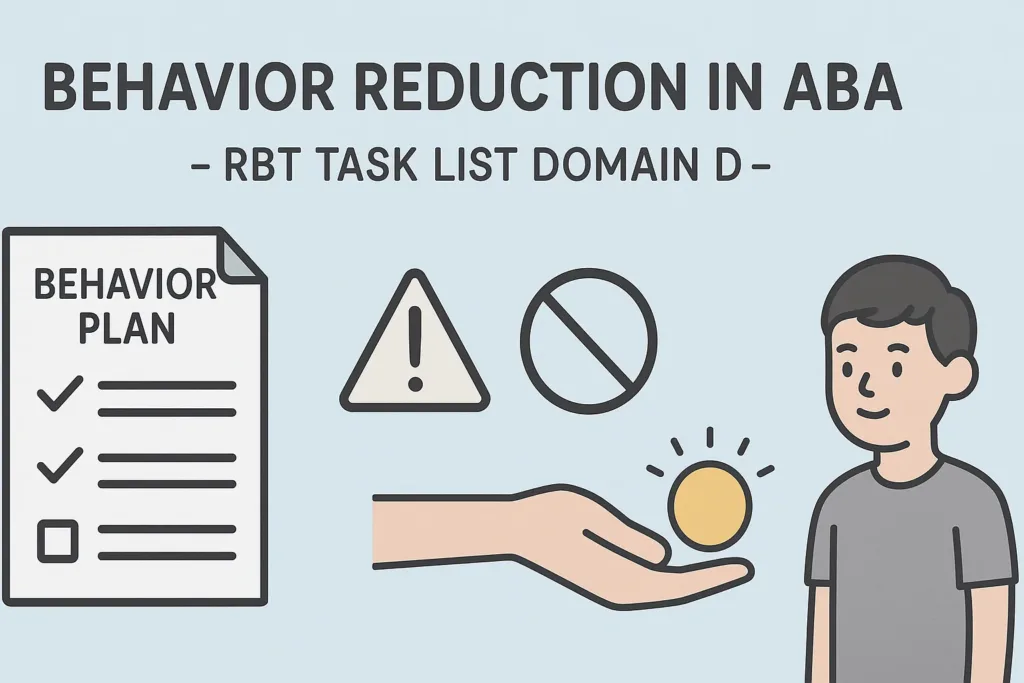
Table of Contents
D-1: Identify Essential Components of a Written Behavior Reduction Plan
A Behavior Intervention Plan (BIP) is a written, individualized plan that outlines how to reduce problem behavior while teaching and reinforcing appropriate replacement behaviors. It is developed by a supervising BCBA and serves as a roadmap for the RBT’s day-to-day responsibilities.
Essential components of a BIP include:
- Operational definition of the target behavior (clear, observable, measurable)
- Identified function of the behavior (based on assessment data)
- Antecedent strategies to prevent the behavior from occurring
- Replacement behaviors to teach
- Consequence strategies (e.g., reinforcement, extinction)
- Crisis procedures if applicable
- Data collection methods
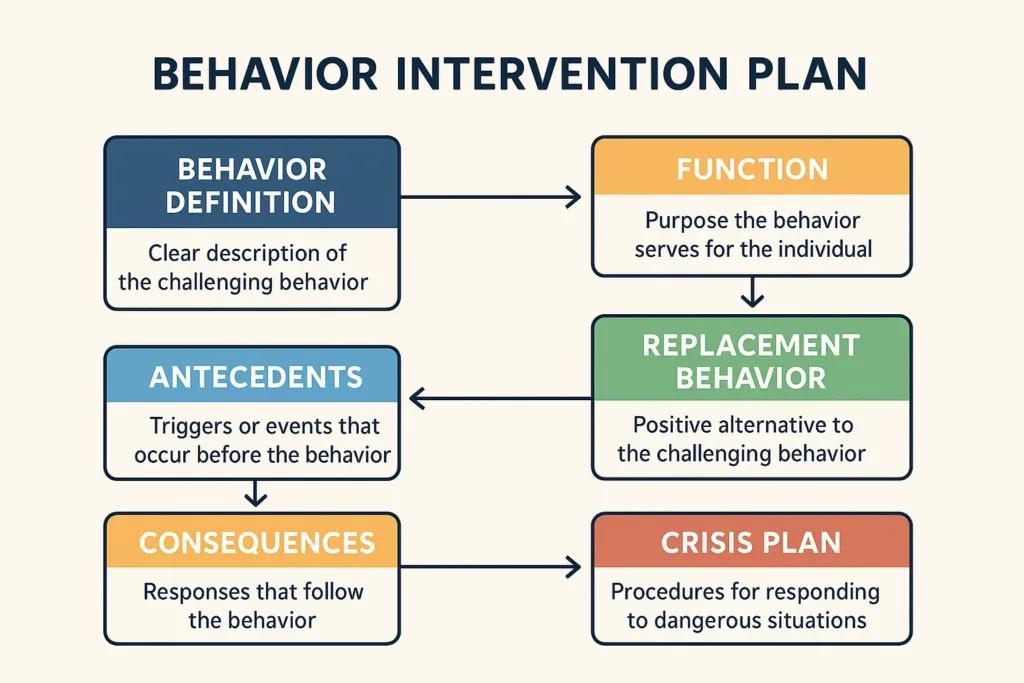
Example: An RBT working with a client who engages in head banging may follow a BIP that outlines how to reduce this behavior through antecedent strategies (offering choices), teaching functional communication (e.g., asking for a break), and implementing extinction when the problem behavior occurs.
Tips for RBTs:
- Review the BIP before each session.
- Ask your supervisor for clarification on any unclear procedures.
- Do not modify the plan without written instruction.
Common mistake: Failing to follow the BIP consistently, or improvising responses to behavior without supervisor approval, which can lead to reinforcement of problem behavior.
D-2: Describe Common Functions of Behavior
Understanding the function of behavior is critical to any functional behavior assessment and helps guide ethical, effective intervention plans. Every behavior, even challenging ones, serves a purpose for the individual. There are typically four primary functions:
- Attention – To gain social interaction or response
- Escape – To avoid or delay a task or situation
- Access to tangibles – To obtain a desired item or activity
- Automatic reinforcement – To gain internal sensory feedback (e.g., hand-flapping for stimulation)
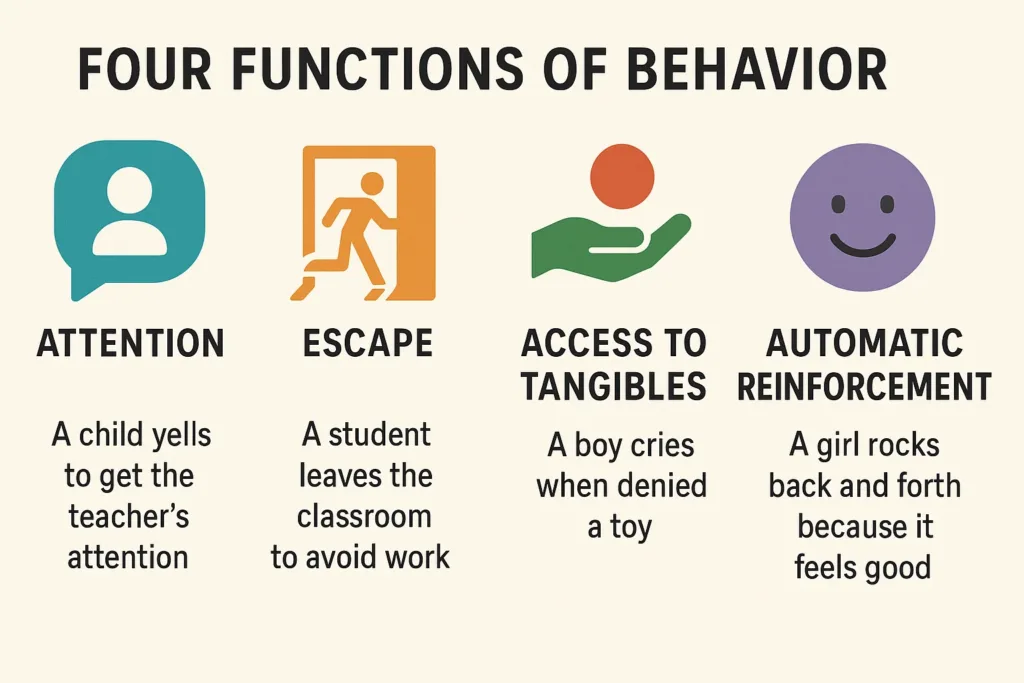
For example, a child might scream during math instruction. If the child is then removed from the task, and the screaming stops, this behavior may be maintained by escape. On the other hand, if the child screams and receives attention, the function may be attention-seeking.
RBTs support function identification by:
- Collecting ABC data (Antecedent-Behavior-Consequence)
- Observing patterns across time and settings
- Reporting observations accurately to the supervisor
Mistakes to avoid:
- Assuming function without data
- Using vague terms like “bad behavior” or “tantrum” instead of descriptive language
- Ignoring subtle forms of automatic reinforcement
Understanding function allows the team to design interventions that are humane, effective, and tailored to the client — not just reactive responses that temporarily suppress behavior.
D-3: Implement Interventions Based on Modification of Antecedents
One of the most proactive strategies in behavior reduction in ABA is modifying the antecedent — what happens before the behavior occurs. By adjusting triggers in the environment or altering the conditions that lead to challenging behavior, RBTs can reduce the likelihood that the behavior will occur at all.
Common antecedent interventions include:
- Noncontingent reinforcement (NCR): Providing access to attention, items, or activities on a schedule, independent of behavior
- Providing choices: Offering the client a say in tasks or transitions to increase cooperation
- Visual schedules and cues: Helping the client anticipate what’s coming next
- Task modification: Changing how a task is presented to make it less aversive
Example: A child becomes disruptive every time a math worksheet is presented. As part of the behavior plan, the RBT offers the child a choice between starting with math or a preferred task. This modification of the antecedent reduces resistance and sets the session up for success.
What RBTs should do:
- Implement antecedent strategies exactly as outlined in the BIP
- Collect data on whether the intervention reduces behavior
- Communicate any unexpected results to the supervisor
Mistakes to avoid:
- Skipping antecedent interventions because “they don’t seem necessary today”
- Inconsistently offering choices or applying modifications
- Using modifications not approved by the supervisor
These strategies are most effective when applied consistently. They also help clients feel more in control and reduce the need for reactive behavior strategies later. Identifying the function of behavior is informed by assessment — visit the Assessment module (B-1 to B-3) for how these functions are discovered.
D-4: Implement Differential Reinforcement Procedures
Differential reinforcement is a powerful, positive strategy used to reduce problem behavior by reinforcing desirable alternatives. Rather than punishing the unwanted behavior, the RBT encourages the client to engage in a replacement behavior by providing reinforcement only for that behavior.
Types of differential reinforcement include:
- DRA (Differential Reinforcement of Alternative Behavior): Reinforce a functionally equivalent alternative
- DRI (Incompatible Behavior): Reinforce a behavior that cannot happen at the same time as the problem behavior
- DRO (Other Behavior): Reinforce the absence of the problem behavior for a set period
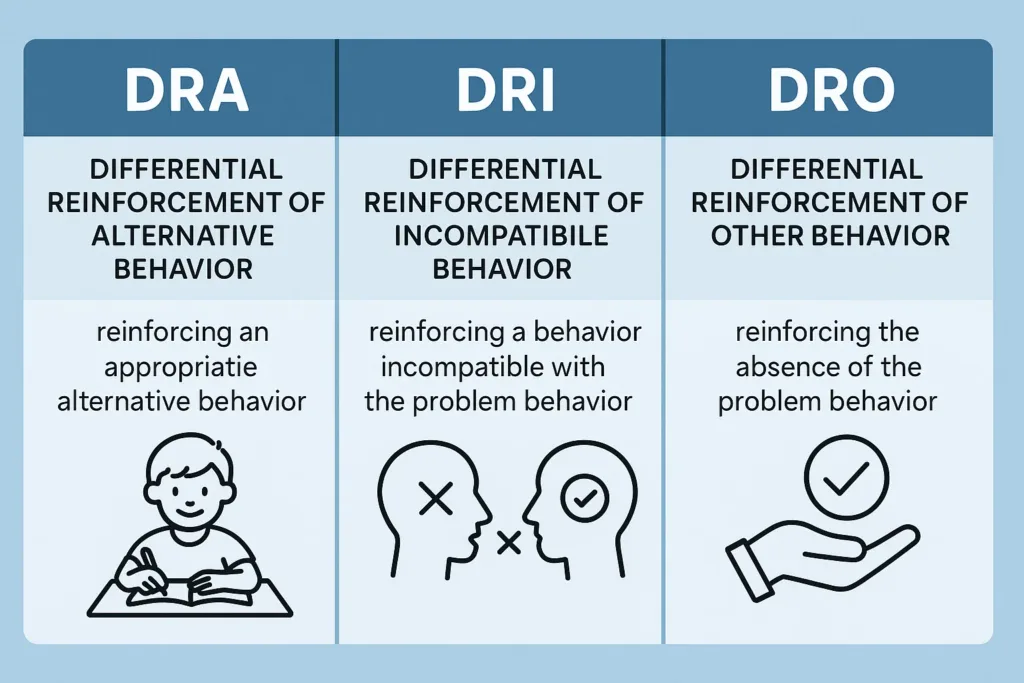
Example (DRA): If a child screams to get a toy, the RBT teaches and reinforces saying “I want toy” instead. Screaming no longer produces the toy; requesting does.
Example (DRI): A child who hits others is taught to clap their hands instead — they can’t hit and clap at the same time.
Tips for implementation:
- Identify and reinforce only the target behavior
- Use consistent, meaningful reinforcers
- Do not reinforce the problem behavior, even by mistake (e.g., giving attention during aggression)
Common pitfalls:
- Reinforcing the wrong behavior (e.g., giving a toy during a tantrum)
- Failing to provide reinforcement immediately after the alternative behavior
- Using DRO without clear timing or criteria
Differential reinforcement aligns with ABA’s ethical commitment to promoting skill building rather than relying on punishment. When implemented properly, it’s one of the most effective strategies RBTs can use.
D-5: Implement Extinction Procedures
Extinction procedures involve the planned withholding of reinforcement for a previously reinforced behavior. When a behavior no longer “works” for the client (i.e., no longer produces the desired outcome), it should decrease over time. This is a highly technical process that must be implemented with consistency, planning, and supervision.
Types of extinction in practice:
- Attention extinction: Ignoring behavior previously reinforced by attention (e.g., no eye contact or response during whining)
- Escape extinction: Not allowing the client to avoid a task (e.g., physically guiding a student to complete a task after aggression)
- Tangible extinction: Denying access to an item that was obtained through problem behavior
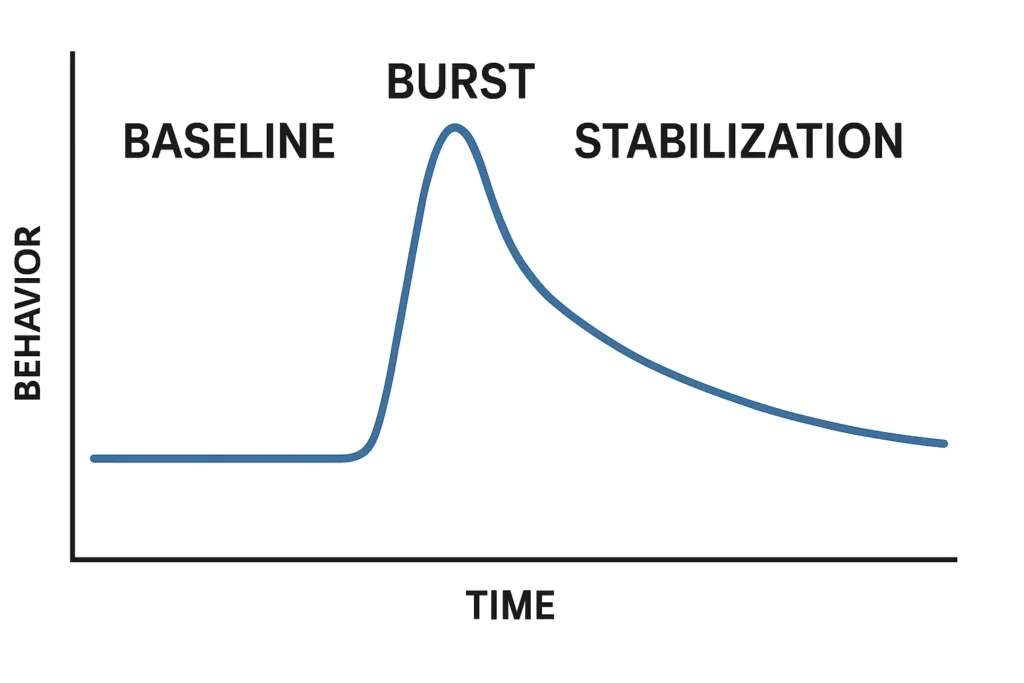
Example: A child bangs on a table to get candy. Under extinction, the RBT no longer gives candy after banging. Instead, the child is taught to ask for candy appropriately, and only that behavior is reinforced.
Important considerations:
- Extinction often results in an extinction burst — a temporary increase in the behavior’s intensity or frequency
- Other side effects may include aggression or emotional responses
- Extinction must be paired with teaching an appropriate replacement behavior
Mistakes to avoid:
- Reinforcing the behavior “just this once” during an extinction burst
- Failing to prepare the environment and team for possible increases in behavior
- Not tracking data to evaluate effectiveness
RBTs must implement extinction procedures only under supervision and with full understanding of the plan. Ethical and safety considerations are critical here. When reducing behavior, teaching alternative responses is key — explore our Skill Acquisition module (C-1 to C-12) for examples of how that’s done.
D-6: Implement Crisis/Emergency Procedures According to Protocol
In certain cases, behavior escalates to a level that poses immediate safety concerns for the client or others. RBTs must know how to respond to these situations in strict alignment with the crisis or emergency protocols outlined in the behavior plan and organization policy.
These procedures may include:
- Blocking or redirection strategies
- Safety equipment usage (if trained)
- Notifying supervisors or guardians
- Activating emergency response if needed (e.g., calling for help)
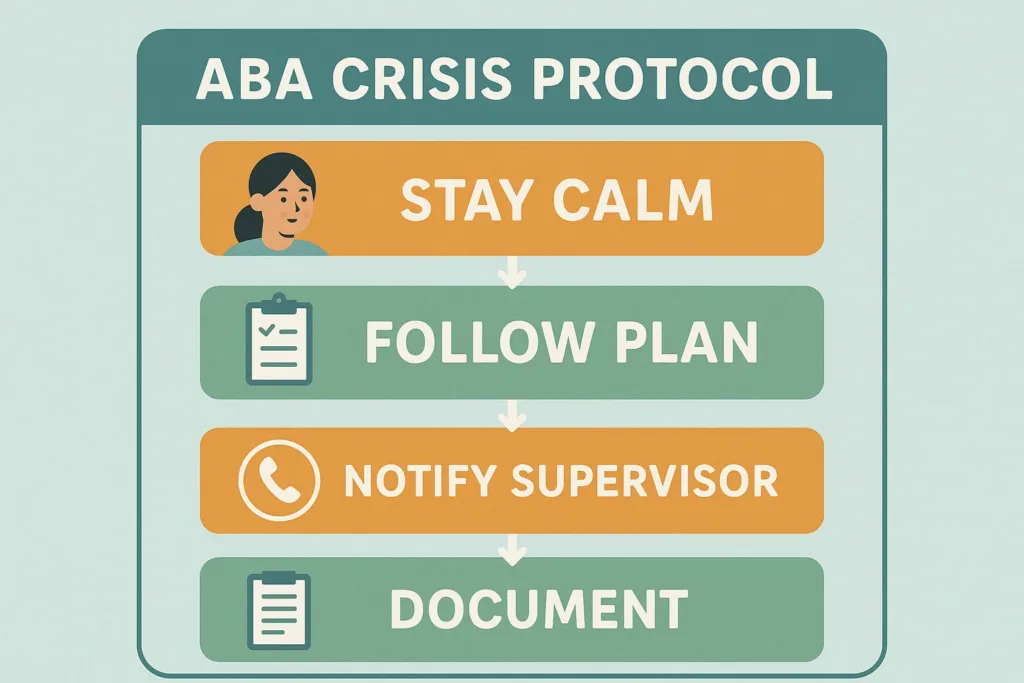
Example: A teen with autism begins to throw objects and attempt to leave the session room. The BIP outlines that the RBT should lock the door (if allowed), move dangerous objects, and contact the supervising BCBA immediately.
What RBTs must do:
- Stay calm and follow the protocol exactly as written
- Avoid implementing procedures that haven’t been trained or authorized
- Document the incident immediately and completely after the event
- Debrief with the team to prevent future occurrences
Common errors:
- Using physical interventions without training or approval
- Forgetting to notify the proper supervisor or parent
- Failing to document an emergency event accurately
RBTs play a crucial role in maintaining a safe environment. Being well-versed in crisis protocols protects clients, caregivers, and professionals alike — and is part of responsible, ethical practice.
Conclusion: Why Behavior Reduction Skills Define Professionalism in ABA
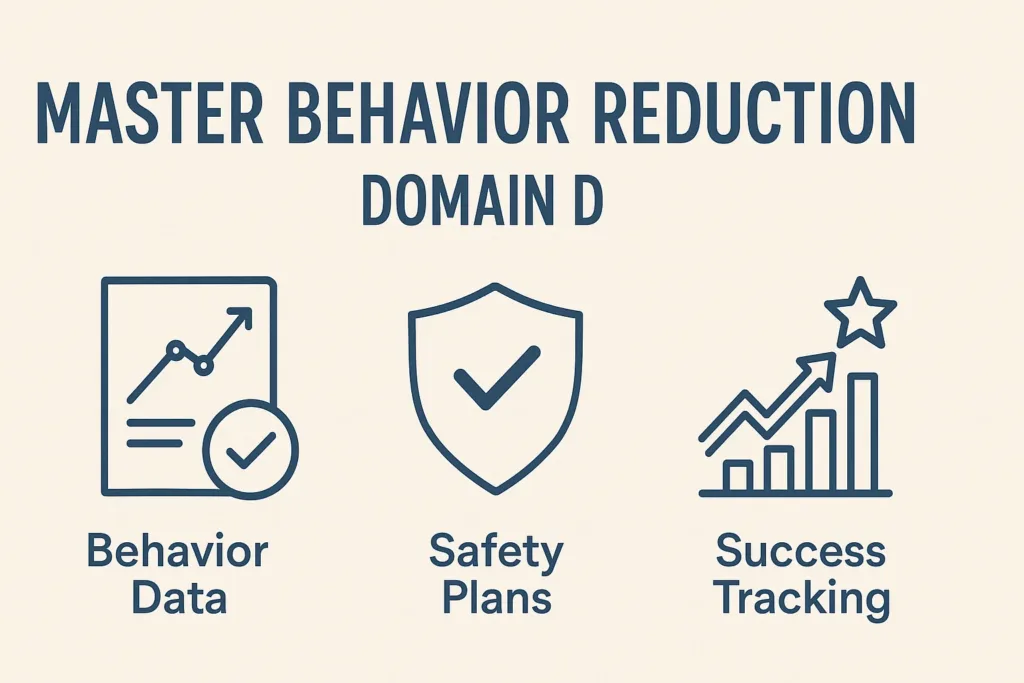
The ability to implement ethical, function-based, and client-centered behavior reduction strategies is one of the clearest markers of an effective RBT. Domain D of the RBT Task List empowers technicians to manage behaviors that interfere with learning, safety, and quality of life — not by suppressing them, but by understanding and replacing them.
By mastering skills like identifying the components of a Behavior Intervention Plan, understanding behavior functions, applying differential reinforcement, and executing extinction procedures and crisis responses correctly, you become a trusted partner in your client’s progress.
As a Registered Behavior Technician, these tasks are not just part of the job — they are a reflection of your professional responsibility, compassion, and commitment to evidence-based care.
To explore all six domains of the Task List, return to our main RBT Study Guide for a complete roadmap to RBT certification.
Want to test your understanding of functions of behavior, extinction, and crisis protocols? Take the Behavior Reduction Practice Test (D-1 to D-6) and reinforce your learning.
